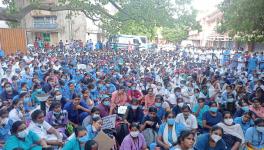COVID-19: Why a Combination of PCR and Serological Tests is our Best Bet
Image Representational use only. image Courtesy: Live Science.com
The SARS CoV-2 (COVID-19) virus has hit 212 countries and the death toll is over 85,000, which is an unequivocally huge number. India is also on the list of countries battling the ghastly disease. Developing an effective vaccine to combat the disease is unquestionably important and experts around the planet are working on it. However, at this point of time, swift diagnosis of the disease is key for appropriate therapeutic and public health intervention. Besides members of the scientific community, people in general would benefit from understanding the scope and limitations of diagnostic tests being used.
At present, two fundamental and methodological approaches have been adopted for COVID-19 testing – tests that detect the virus itself, and tests that detect antibodies developed against the virus. For direct detection of the virus, a molecular diagnostic test called Polymerase Chain Reaction (PCR) [more specifically, Reverse Transcriptase Polymerase Chain Reaction (RT-PCR)] is used. In PCR, a single copy of DNA is amplified to millions and millions of copies courtesy an equipment called the thermocycler.
The RT-PCR Method:
The SARS CoV-2 is a respiratory virus and is mostly likely to be found in the upper and lower respiratory tracts. Therefore, samples for PCR testing are often obtained by carefully inserting a sterile cotton swab into the nasopharyngeal area (the region where the nose joins the throat) and the method is considered to be the most effective. In some instances, when the patient is intubated or in cases when there is too much phlegm obstructing the nasal cavity, expelled sputum is preferred.
The collected samples are then transported carefully to the concerned laboratories and subjected to RT-PCR. Subsequently, the nucleic acid component of the virus has to be isolated. The nucleic acid encodes the genetic material of the virus and it could be either DNA or RNA. SARS CoV-2 is an RNA virus. Generally, RNA is more fragile compared to DNA – one of the reasons is that DNA has two strands whereas RNA is single stranded for most viruses. In other words, most RNA viruses are prone to rapid degradation which makes their isolation and storage even more challenging and COVID-19 is no exception.
Yet another feature of RNA viruses is that unlike DNA, the isolated RNA cannot be directly amplified by PCR. It is because an enzyme called Taq DNA polymerase is crucial in catalysing the PCR process and this enzyme acts only on DNA and not on RNA. Hence, immediately after the RNA is isolated, the next stepis the conversion of isolated RNA into complementary DNA (cDNA) through a series of steps.
For cDNA synthesis, an enzyme called reverse transcriptase (RT) is added and it is why the entire process is called RT-PCR. Finally, the cDNA is amplified to millions of copies in a thermocycler. The positive samples will then be sequenced (order of nucleotides in a genome is called sequence) and the sequences will then be compared with the sequences of other positive isolates that have already been submitted to repositories. It is how a sample is declared positive or negative by the PCR.
The Serological Testing Method
In the second approach, which could be more accurately termed serological testing, the virus itself is not detected; rather, the antibody which is secreted in response to the virus is detected. An antibody is nothing but a protective protein which is produced by specialised white blood cells called B-lymphocytes when they encounter a foreign substance (in this case, the SARS CoV-2). Antibody molecules can be simply categorised as glycoproteins called immunoglobulins (Ig). There are five different types of Ig secreted in the body, of which only IgG and IgM are present in detectable quantities in blood serum. IgM is detected between three to five days after infection and IgG can be spotted ten days after infection.
Kits containing cassettes are available for rapid detection of the SARS CoV-2.. The cassette contains recombinant SARS CoV 2 protein conjugated to coloured particles. This part is arduous, since some parts of the virus may share similarities with coronaviruses other than SARS CoV-2. For COVID-19 testing, whole blood or serum is preferred. When a sample is added to the cassette, any IgG or IgM antibody present in the sample will readily bind to the viral proteins and form complexes. This in turn leads to the formation of a colored band and thus functions in a manner similar to the pregnancy or HIV rapid tests. Very recently, the ICMR has approved 7 rapid diagnostic kits in the country.
Serological tests can be readily performed in a clinical laboratory while RT-PCR requires a laboratory equipped with no less than Biosafety level-2 facility. Also, rapid diagnostic kits that detect antibodies take between 15 and 30 minutes to deliver the result, which is much lesser than the time required for conducting PCR. Antibody detection tests would be very useful for epidemiological studies and further research concerned with the development of vaccine. This is because the antibodies developed against the virus keep circulating in the blood for a considerable time period.
However, the question of accuracy might arise with the rapid test. Antibodies take a minimum of one week to be detected in blood and hence serological tests alone cannot rule out the presence of the virus in early stages of infection unlike RT-PCR, which could detect the virus during the early stages of the disease. In a recent advisory, the World Health Organisation (WHO) has recommended the use of PCR for COVID-19 diagnosis. Nevertheless, with the increasing number of cases, it is not feasible to screen a large number of samples by RT-PCR within a limited period of time. Therefore, a combination of both methods could yield satisfactory results which the ICMR has strategised recently.
Kits for antigen detection are also being developed. Akin to PCR, this method detects the virus, but does not require amplification; instead, the viral proteins in the suspected sample are detected when they form complexes with the antibody previously fixed on a paper strip. At the end of 30 minutes, a positive reaction is indicated by a visually detectable signal. This method overcomes the major limitations of the other two methods and could pave way for an even more reliable result in the early stage of infection within a short span of time.
The author is a veterinary microbiologist. The views are personal.
Get the latest reports & analysis with people's perspective on Protests, movements & deep analytical videos, discussions of the current affairs in your Telegram app. Subscribe to NewsClick's Telegram channel & get Real-Time updates on stories, as they get published on our website.
























